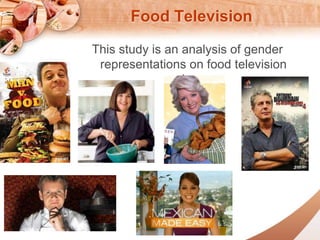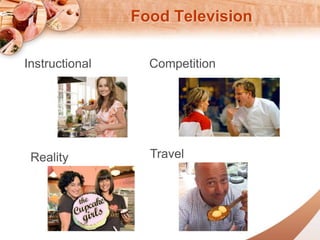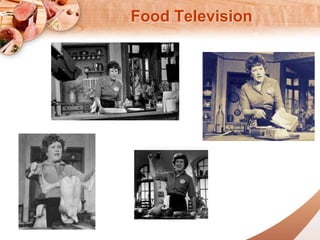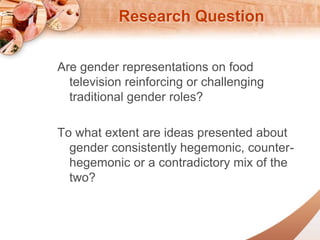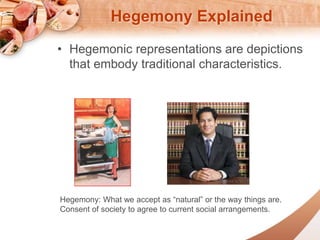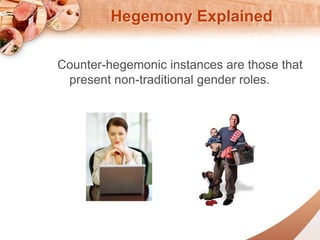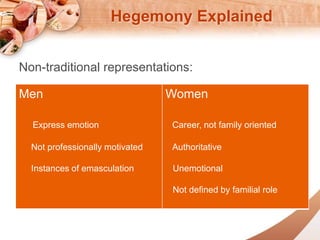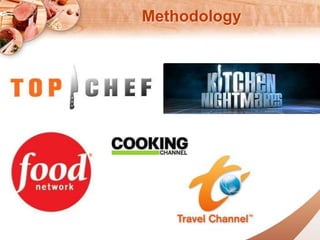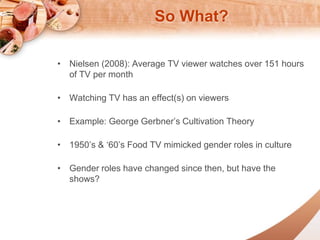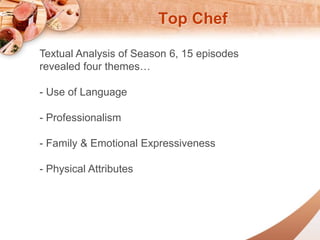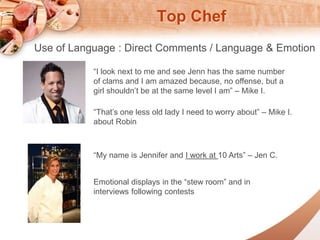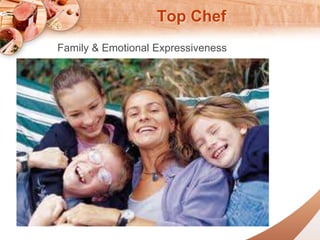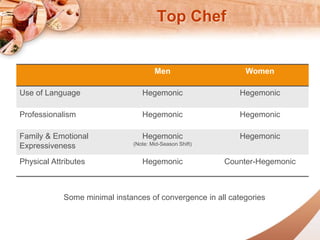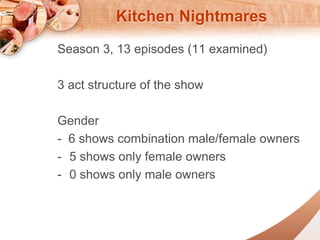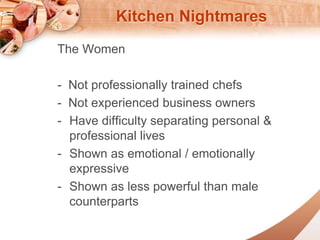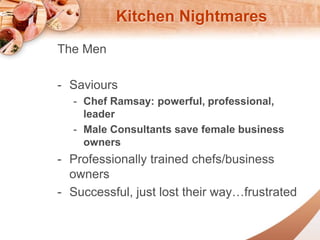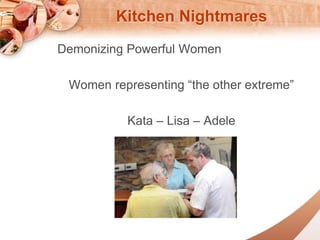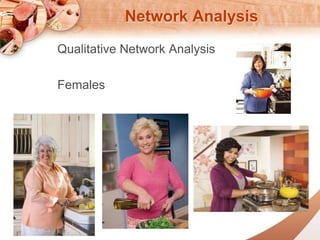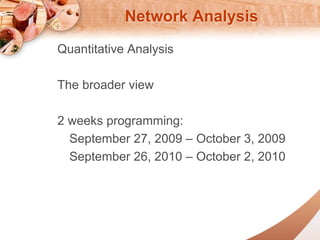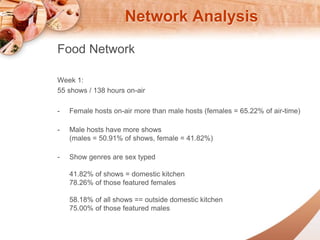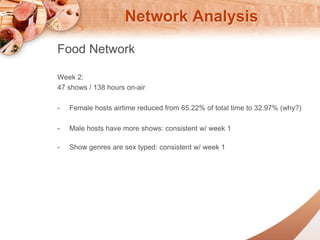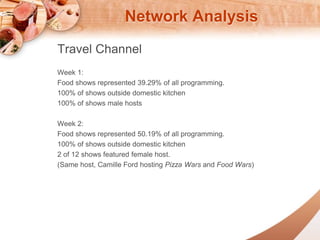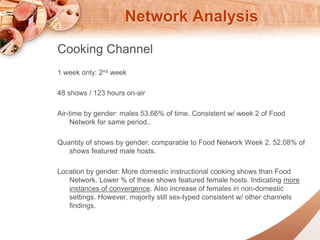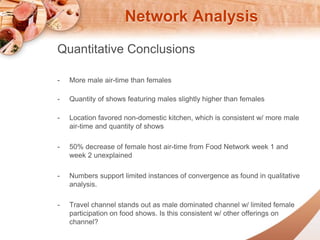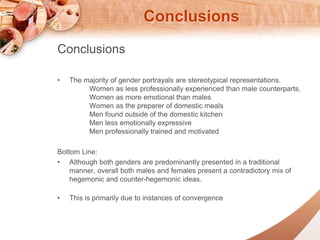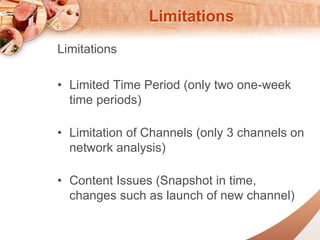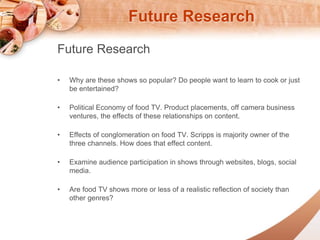Analysis of Gender Representations on Food Television
- 1. Grilling with Gas and Baking with Class: An Analysis of Gender Representations on Food Television Evan L. Kropp
- 2. Food Television This study is an analysis of gender representations on food television shows
- 3. Food Television Instructional Competition Reality Travel
- 5. Research Question Are gender representations on food television reinforcing or challenging traditional gender roles? To what extent are ideas presented about gender consistently hegemonic, counter-hegemonic or a contradictory mix of the two?
- 6. Hegemony Explained ? Hegemonic representations are depictions that embody traditional characteristics. Hegemony: What we accept as “natural” or the way things are. Consent of society to agree to current social arrangements.
- 7. Hegemony Explained Traditional Characteristics include: Men Displays of Authority Power Self-Reliant Professionally Successful Not emotionally expressive Women Mothers Homemakers Not professionally motivated Emotionally expressive Sexualized
- 8. Hegemony Explained Counter-hegemonic instances are those that present non-traditional gender roles.
- 9. Hegemony Explained Non-traditional representations: Men Express emotion Not professionally motivated Instances of emasculation Women Career, not family oriented Authoritative Unemotional Not defined by familial role
- 10. Methodology
- 11. So What? ? Nielsen (2008): Average TV viewer watches over 151 hours of TV per month ? Watching TV has an effect(s) on viewers ? Example: George Gerbner’s Cultivation Theory ? 1950’s & ‘60’s Food TV mimicked gender roles in culture ? Gender roles have changed since then, but have the shows?
- 12. Top Chef Textual Analysis of Season 6, 15 episodes revealed four themes… - Use of Language - Professionalism - Family & Emotional Expressiveness - Physical Attributes
- 13. Top Chef Use of Language : Direct Comments / Language & Emotion “I look next to me and see Jenn has the same number of clams and I am amazed because, no offense, but a girl shouldn’t be at the same level I am” – Mike I. “That’s one less old lady I need to worry about” – Mike I. about Robin “My name is Jennifer and I work at 10 Arts” – Jen C. Emotional displays in the “stew room” and in interviews following contests
- 14. Top Chef Professionalism Ron Mattin Contestants: 50/50 Gender Split Judges: 15 Total, 12 Males, 3 Females “I haven’t done this in a while, I just took two years off to be a mom” – Jen Z.
- 15. Top Chef Family & Emotional Expressiveness
- 16. Top Chef Physical Attributes
- 17. Top Chef Men Women Use of Language Hegemonic Hegemonic Professionalism Hegemonic Hegemonic Family & Emotional Expressiveness Hegemonic (Note: Mid-Season Shift) Hegemonic Physical Attributes Hegemonic Counter-Hegemonic Some minimal instances of convergence in all categories
- 18. Kitchen Nightmares Season 3, 13 episodes (11 examined) 3 act structure of the show Gender - 6 shows combination male/female owners - 5 shows only female owners - 0 shows only male owners
- 19. Kitchen Nightmares The Women - Not professionally trained chefs - Not experienced business owners - Have difficulty separating personal & professional lives - Shown as emotional / emotionally expressive - Shown as less powerful than male counterparts
- 20. Kitchen Nightmares The Men - Saviours - Chef Ramsay: powerful, professional, leader - Male Consultants save female business owners - Professionally trained chefs/business owners - Successful, just lost their way…frustrated
- 21. Kitchen Nightmares Demonizing Powerful Women Women representing “the other extreme” Kata – Lisa – Adele
- 22. Network Analysis Qualitative Network Analysis Females
- 23. Network Analysis
- 25. Network Analysis Quantitative Analysis The broader view 2 weeks programming: September 27, 2009 – October 3, 2009 September 26, 2010 – October 2, 2010
- 26. Network Analysis
- 27. Network Analysis
- 28. Network Analysis Food Network Week 1: 55 shows / 138 hours on-air - Female hosts on-air more than male hosts (females = 65.22% of air-time) - Male hosts have more shows (males = 50.91% of shows, female = 41.82%) - Show genres are sex typed 41.82% of shows = domestic kitchen 78.26% of those featured females 58.18% of all shows == outside domestic kitchen 75.00% of those featured males
- 29. Network Analysis Food Network Week 2: 47 shows / 138 hours on-air - Female hosts airtime reduced from 65.22% of total time to 32.97% (why?) - Male hosts have more shows: consistent w/ week 1 - Show genres are sex typed: consistent w/ week 1
- 30. Network Analysis Travel Channel Week 1: Food shows represented 39.29% of all programming. 100% of shows outside domestic kitchen 100% of shows male hosts Week 2: Food shows represented 50.19% of all programming. 100% of shows outside domestic kitchen 2 of 12 shows featured female host. (Same host, Camille Ford hosting Pizza Wars and Food Wars)
- 31. Network Analysis Cooking Channel 1 week only: 2nd week 48 shows / 123 hours on-air Air-time by gender: males 53.66% of time. Consistent w/ week 2 of Food Network for same period.. Quantity of shows by gender: comparable to Food Network Week 2. 52.08% of shows featured male hosts. Location by gender: More domestic instructional cooking shows than Food Network. Lower % of these shows featured female hosts. Indicating more instances of convergence. Also increase of females in non-domestic settings. However, majority still sex-typed consistent w/ other channels findings.
- 32. Network Analysis Quantitative Conclusions - More male air-time than females - Quantity of shows featuring males slightly higher than females - Location favored non-domestic kitchen, which is consistent w/ more male air-time and quantity of shows - 50% decrease of female host air-time from Food Network week 1 and week 2 unexplained - Numbers support limited instances of convergence as found in qualitative analysis. - Travel channel stands out as male dominated channel w/ limited female participation on food shows. Is this consistent w/ other offerings on channel?
- 33. Conclusions Conclusions ? The majority of gender portrayals are stereotypical representations. Women as less professionally experienced than male counterparts. Women as more emotional than males Women as the preparer of domestic meals Men found outside of the domestic kitchen Men less emotionally expressive Men professionally trained and motivated Bottom Line: ? Although both genders are predominantly presented in a traditional manner, overall both males and females present a contradictory mix of hegemonic and counter-hegemonic ideas. ? This is primarily due to instances of convergence
- 34. Limitations Limitations ? Limited Time Period (only two one-week time periods) ? Limitation of Channels (only 3 channels on network analysis) ? Content Issues (Snapshot in time, changes such as launch of new channel)
- 35. Future Research Future Research ? Why are these shows so popular? Do people want to learn to cook or just be entertained? ? Political Economy of food TV. Product placements, off camera business ventures, the effects of these relationships on content. ? Effects of conglomeration on food TV. Scripps is majority owner of the three channels. How does that effect content. ? Examine audience participation in shows through websites, blogs, social media. ? Are food TV shows more or less of a realistic reflection of society than other genres?


